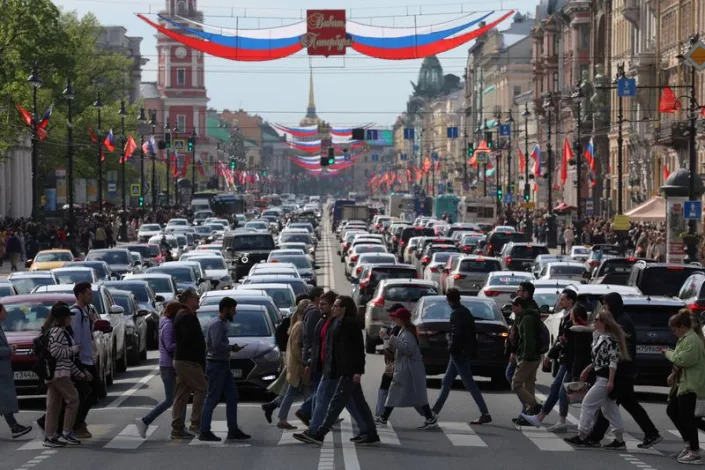
Pedestrians walk across Nevsky Avenue in central Saint Petersburg
Reuters
Fri, March 24, 2023
MOSCOW (Reuters) - Russia's middle class will shrink as social inequality grows over coming years, an economic study conducted by Russian experts suggested, as sanctions against Moscow and limited growth potential scupper development prospects.
The study, published this week, presents four possible scenarios for how Russians' living standards will change between now and 2030 from experts from the Social Policy Institute at Moscow's Higher School of Economics, one of Russia's leading educational establishments.
The study, based on a 2022 survey of experts from economic institutions, businesses and public organisations, states that only a combination of global economic growth and an easing of sanctions on Russia, imposed by the West because of what Moscow calls its "special military operation" in Ukraine, can improve real incomes and reduce poverty.
The middle class is set to suffer in any event, even if sanctions pressure is reduced, the study finds.
Russia's economy proved unexpectedly resilient in the face of tough Western sanctions last year, but a return to pre-conflict levels of prosperity may be far off as more government spending is directed towards the military.
The study's most optimistic scenario sees real incomes exceeding 2021 levels by around 2% in 2030 and poverty dropping below 10% from 11.8% in 2022. In that scenario, the size of the middle class would still drop to 14%-31% by 2030 from current estimates of 20%-50%.
"Thus, even in the most favourable development of events, one can expect the deterioration of the middle class and of the population's social and psychological well-being," the study's authors write.
The worsening scenarios eventually see real incomes declining up to 2030 and poverty approaching 20%.
"On the one hand, there will be an increase in the concentration of wealth and a further breakaway at the 'top', and on the other hand, a contraction of inequality below through the convergence of the middle (or formerly middle) strata with the poor," the authors say.
Growing inequality in all four scenarios could lead to increased social tensions, the study finds. All four scenarios expect more and more security officials to drop into the middle class.
(Reporting by Darya Korsunskaya; Writing by Alexander Marrow; Editing by Nick Macfie)
The study's most optimistic scenario sees real incomes exceeding 2021 levels by around 2% in 2030 and poverty dropping below 10% from 11.8% in 2022. In that scenario, the size of the middle class would still drop to 14%-31% by 2030 from current estimates of 20%-50%.
"Thus, even in the most favourable development of events, one can expect the deterioration of the middle class and of the population's social and psychological well-being," the study's authors write.
The worsening scenarios eventually see real incomes declining up to 2030 and poverty approaching 20%.
"On the one hand, there will be an increase in the concentration of wealth and a further breakaway at the 'top', and on the other hand, a contraction of inequality below through the convergence of the middle (or formerly middle) strata with the poor," the authors say.
Growing inequality in all four scenarios could lead to increased social tensions, the study finds. All four scenarios expect more and more security officials to drop into the middle class.
(Reporting by Darya Korsunskaya; Writing by Alexander Marrow; Editing by Nick Macfie)
.jpg)
No comments:
Post a Comment